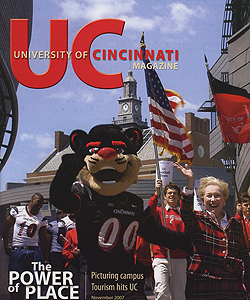The University of Cincinnati is responding to the growing popularity of campus tours.
by Mary Niehaus
A St. Louis architectural firm closed its offices for a day and brought 20 staff members to the University of Cincinnati for a tour. On a different occasion, Columbus architects visiting campus for student portfolio reviews were so excited over UC's signature architecture and green spaces that they came back with 40 other professionals in tow. Another time, a young professional couple from St. Louis requested a tour because they had read about the university and were thinking of moving to Cincinnati.
Tourism has hit UC.
The number of prospective students and parents taking traditional admissions tours was up an astonishing 50 percent in the 2006-07 academic year, with 12 student guides leading approximately 3,000 people through campus. "Once people visit UC, they find it is way beyond their expectations for what they thought they would see on an urban campus," explains Tom Canepa, assistant vice president for admissions.
But considering that the national media has been praising UC's campus environment for more than 10 years, a growing number of visitors has been requesting tours that go a step beyond the scope of student guides. To remedy the situation, UC's Center for the City initiated the Campus Guides program last year to provide customized tours to special groups of professionals, alumni and civic-minded individuals, says executive director Mary Stagaman.
Welcoming these groups to campus are a dozen volunteer administrators, faculty, staff and alumni who took a 10-week course to learn docent techniques and to beef up their knowledge of campus architecture, public art and landscaping. To expand the program's availability, more docents are being recruited, from both employees and alumni, for another training session next year.
"Architects especially enjoy coming to the UC campus because there are so many signature-architect works within a short distance," says the campus guide who knows best, assistant professor of architecture Alexander Christoforidis, whose niche is leading tours for groups of architects. "At UC, both the number of signature buildings and our cohesive Master Plan make the university really stand out."
Visiting architects who tour the UC campus express surprise, appreciation and perhaps a little envy at what they see, according to Christoforidis. "After all," he says, "signature architects are the 'stars' of our profession."
Awe-filled reactions to the University of Cincinnati, of course, aren't restricted to architects. Alumni are similarly astonished by the improvements made since they were students. The most startling, perhaps, is the transformation of the former giant parking lot near the Alumni Center into Campus Green, a park-like area featuring an arboretum, benches, winding paths and a water fountain cascading down limestone steps.
"People are amazed at what has happened on this campus," Christoforidis says. "UC's achievement is seen as something quite significant."

 Issue Archive
Issue Archive

